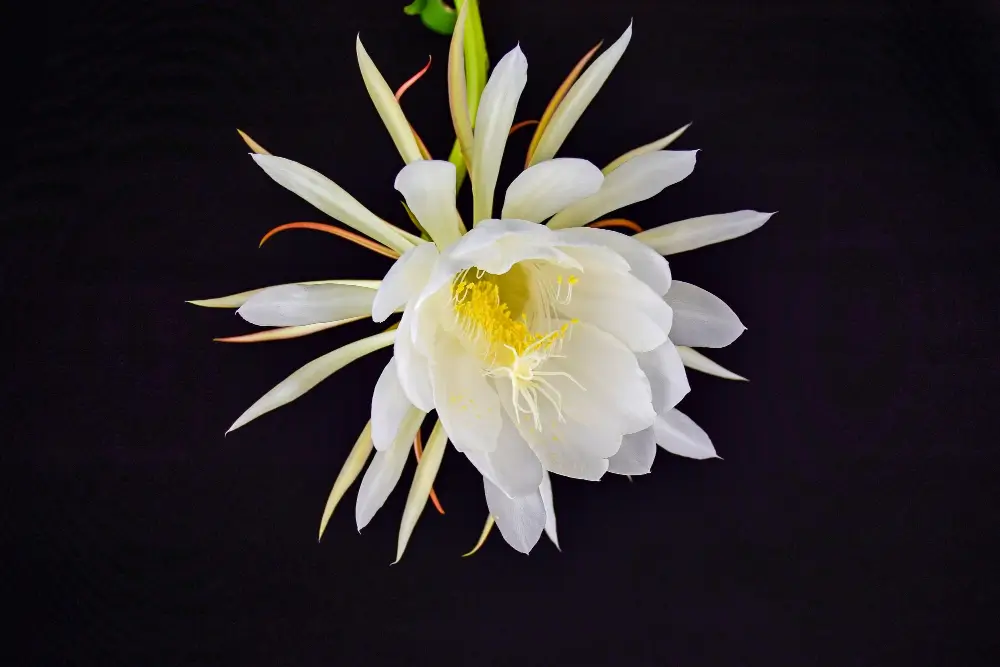
Queen of the Night Flower care: Growing epiphyllum oxypetalum indoors
Gardeners are always drawn to the beauty of plants. Not only all plants of all sizes and types look wonderful, but they also have unique traits. For example, the vibrant colors and distinct shapes of all flowers each give a charming appearance to any garden. Queen of the Night flowers are unforgettable due to their blooming only under the cover of darkness. Moreover, this cactus flower opens to reveal its rich scent and stunning white flower petals, which make it unforgettable.
Although various common plants bloom beautifully all year with their vibrant leaves and colors, the flowers bloom for just a night. Even though the plant blooms for only a few hours, it draws immediate attention and gives a softer inclusion to open spaces due to the delicate, white flowers.
Aside from adding aesthetics, this plant might offer another interesting encounter to a collection. The saying may have little relevance to a flower garden, but it can apply to the grower’s collection. This plant, which may be grown both outside and inside, is ideal for both types of gardens. Likewise, it flowers at night and easily adapts to light conditions and can flourish in low-light conditions as the days get shorter. While this property may require regular transportation, it will produce short-lived but spectacular flowers. A unique flower experience is offered by this plant, which is fit for everyone willing to have something out of the ordinary as part of their collection.
People seeking to add fantastic plants to their collection have access to high-quality plants via Growcycle. However, exceptional care will guarantee beautiful blossoms and growth for the plant. All the essential gardening tools and equipment may be found in their facility. These include all the requirements for flourishing plants.
History and Origin
The Queen of the Night is a very unusual cactus with a lot of history. This cactus, from Central and South America, is scientifically known as Epiphyllum oxypetalum. It was very highly regarded by native people for its lovely, night-blooming flowers that formed an integral part of cultural observances. When the flowers unfurl in the darkness, they serve as a symbol of beauty and the fleetingness of life. Such a connection to nature was important to these communities.
In the early 1900s, this plant reached Europe, where people quickly loved it. Many people took a glance at its unique blooms, beautiful flowers. These nocturnal blooms inspired many writers and artists. Due to this reason, this flowering plant is also called "Night Blooming Cereus". Over the years, there was a better way to cultivate. This helped more people learn to grow this special plant at home and in gardens. Although an easy plant to care for, it represents the transience of beauty.
Related: Live plants
Physical Appearance
The Queen of the Night is absolutely beautiful. This wonderful flowering cactus has long flat stems with a serrated edge. These stems can reach impressive heights of ten feet, bringing wow-factor to your garden. But its true glory is in its flowers. Each blooms like a giant, fragile water lily with its white petals reaching up to 12 inches across. That fragrance wafted through the night air, and the flowers alone, shining so beautifully, made this visit memorable.
This plant’s appearance is not its only selling point; the leathery, rich, dark green leaves are the perfect backdrop for the vibrant clusters. Known as storage leaves due to the fact that they can maintain massive amounts of water, these plants are similar to cacti and can endure different weather. The combination of its structural elegance and floral beauty makes the Queen of the Night a standout in any collection.
Important Features of Queen of the Night
Below are the salient features of the Queen of the Night flower:
Night Blooming
The Queen of the Night is known for its unique blooming style. When large flowers open at night, the air is filled with a lovely aroma. This beautiful sight brings joy to everyone who sees it in the evening, and each flower adds a sense of wonder to the night.
- Impressive Size
Stems that can grow as long as 120 inches make this cactus eye-catching in any garden or indoor area, distinguishing itself from the surrounding plants.
- Unique Flowers
The blossoms are large, and the width of the white petals reaches 12 inches. The petals are soft and beautiful. They also have a sweet scent, which makes seeing the flowers even more enjoyable.
- Resilience and Care
The Queen of the Night has strong, thick leaves that are great at holding onto water. This special feature helps the plant thrive in different weather and conditions when looked after properly.
Types of Epiphyllum Oxypetalum
Queen of the Night includes different types and varieties, each with its own special features while keeping the magical charm that makes this plant so popular. Below are some interesting types.
Selenicereus Grandiflorus
Selenicereus grandiflorus is the most common type of Queen of the Night plant. It shows off big, bright white flowers. These flowers bloom at night and create a beautiful view for all to see. This type of cactus grows best in warm places. Many people plant it for its lovely flowers, and anyone who sees it draws their attention to it.
Selenicereus Undatus
The Selenicereus undatus (Dragon Fruit cactus) is another type of Queen of the Night. This plant produces yellow or pink fruit. The flowers bloom at night and are very beautiful. The fruit is safe to eat and is popular among many people. This makes the Dragon Fruit cactus appealing for gardeners. It offers both lovely flowers and tasty fruit.
Selenicereus Megalanthus
Commonly called the Yellow Pitaya, this species is known for its bright yellow fruits and smaller flowers. Its unique appearance adds a lively touch to the usual Queen of the Night varieties. This plant is also known for being tough and able to grow well in different environments.
Selenicereus Setaceus
Selenicereus setaceus is a less-known variety with long, slender stems and delicate flowers. While its blooms may be smaller, they remain exquisite in their own right and contribute to a diverse display for indoor or outdoor gardens.
How to Choose the Right Type of Plant?
Choosing the best Queen of the Night flower for a collection requires considering different factors that match the space and gardening preferences. Start by checking the climate, as Selenicereus grandiflorus works well in warm areas. It offers a classic look with its big, beautiful flowers that bloom at night. The Selenicereus undatus, known as the Dragon Fruit cactus, is perfect for those who want both beauty and usefulness, as it produces lovely flowers and tasty fruit.
For a burst of color, the Selenicereus megalanthus stands out with its bright yellow fruits and beautiful flowers, adding a special touch to any plant collection. For those with limited space or a desire for something unique, the slender and delicate Selenicereus setaceus brings charm to the display. It's important to consider how to care for each plant, paying attention to their needs and strengths to ensure they thrive in the garden.
Related: Bird of Paradise care: Growing strelitzia for exotic blooms
Growing Epiphyllum Oxypetalum Indoors
Growing the Queen of the Night flower brings much joy, and following some clear steps ensures this plant stays healthy and beautiful. Here are the important steps needed to grow it successfully.
Preparation of the Soil
Preparing the soil for the Queen of the Night flower is key for strong growth. Gardeners must start with a well-draining potting mix designed specifically for succulents and cactus. This mix often has coarse sand, perlite, peat, or coconut coir. These materials facilitate the easy passage of water while retaining the roots from becoming overly damp.
Adding organic fertilizer before planting can give the plant important nutrients. Choosing a pot with drainage holes is also necessary to let excess water drain away. If planting in the ground, check the soil drainage. If the soil is excessively dense or retains too much water, sand or gravel can be added to assist drainage.
Lighting Conditions
The Queen of the Night flourishes in bright and indirect sunlight. It's important if you want good growth and blooming. It likes to be near a window, receiving filtered light for several hours a day. However, they thrive better in shaded areas; hence, covering them from the bright afternoon sun is highly recommended, as the sunlight can scorch their delicate stems and leaves.
During the growing season — spring through early fall — around 6 to 8 hours of indirect light daily keeps it growing well and flowering. If you do not have access to sufficient natural light you can use flowering grow lights.
Watering Schedule
Watering the Queen of the Night plant is important. However, it is necessary to avoid giving too much water, as overwatering can cause root rot. The growing season runs from spring to early fall; throughout that time, the soil should be slightly damp but not soggy. Watering when the top inch of soil seems dry is the right way for proper growth.
Water about every two to three weeks, depending on temperature and humidity. It is advisable to water the cactus less during the cooler months when it is inactive. Also, it is wise to water in the morning. This allows the plant to soak up moisture during the day and stops water from sitting overnight, which can cause pests or diseases.
Temperature and Humidity
This plant does best in 65-85 °F (18 °C and 29°C), so moderate climates are best. But extreme hot or cold can put the plant under stress and result in variability in its blooming cycle. So it is best to avoid temperatures below 10°C (50°F) or above 32°C (90°F).
The best and ideal humidity level for the growth of Queen of Night is 50-60%. This plant appreciates moisture, so it’s beneficial to mist it regularly or keep it next to a humidifier of it’s indoors, especially when the air is dry or when air conditioning is in use. Well-regulated humidity means good development and reliable flowering.
Potting and Repotting
Choosing the right container and pots encourages Queen of the Night growth. Housing pots should be very well-draining (lots of holes!). This helps avoid water pooling and root rot. Clay pots are a good choice. They enable excess moisture to evaporate, helping maintain the soil at just the right level for the plant.
It is important to choose the right size pot. A pot needs sufficient space for the roots to extend. Well-grown roots will not fit in a pot that is too small. This could result in less blossoming and gradual growth. But too big a pot can hold too much soil, and too much soil can keep the roots too moist, which is bad for the cactus.
The Queen of the Night cactus is repotted every 2 years. It helps preserve the soil, gives the roots more space to grow, and retains more moisture. The pot should be slightly larger each time repotting is done. This gives roots the space they need. For it to flourish and put out lovely blooms, it requires proper care.
Planting
Plant it carefully. Handling the plant’s spines can be painful. The cactus should be placed in the center of the pot. Cover it up, but not too deep, just cover the roots. Lightly pack in some soil around the plant, which will help give your cactus stability.
Benefits of Queen of the Night
Some most important benefits of Queen of Night flower are as follows:
Appealing to the Eyes
This plant is different from other plants with its beautiful flowers. These flowers bloom only at night and have a sweet scent. The big, colorful flowers can turn any yard or indoor area into one big show. This plant is also famous for its unique beauty and the fabulous touch it provides to the atmosphere.
Air Purification
Some houseplants are known to purify the air, such as Queen of the Night. This plant can enhance the air quality of a home by absorbing CO2 and emitting oxygen. A cleaner space contributes to a cleaner environment.
Low Maintenance
The Queen of the Night flower is easy to look after, making it ideal for busy people or novice gardeners. It does well under a variety of conditions and doesn’t need watering often, which makes it perfect for bringing greenery into a home without requiring too much time to care for.
Edible Fruit
Certain varieties of the Queen of the Night bear edible fruits. For example, Dragon Fruit cactus or Selenicereus undatus. Fruits are not only delicious but also the healthiest food you could eat. It provides yet another reason for cultivating the plant. Gardeners can appreciate the lovely flowers and enjoy fresh, tasty fruit as well.
Symbolic Meaning
The Queen of the Night is a symbol of beauty and love in many cultures. This plant reflects the unique character of the night and the beauty that awakens when the sun goes down. This cactus will definitely add some real beauty and appeal to a home or garden.
How to Propagate Queen of the Night Flower
To propagate Queen Of The Night flower take a healthy stem. Find a healthy stem that is at least four to six inches long. The easiest and safest way is to either use a sharp pair of scissors or a knife, cutting through the stem at the end where it attaches to the flower base for a clean cut.
Allow the stem to dry in a dark place for a few days after cutting. This prepares the cut end to create a callus so it doesn’t rot when you plant it. As the stem is drying, get a small pot with drainage holes filled with a well-draining cactus or succulent potting mix. You may want to mix in some perlite or sand to help with drainage.
When your stem is ready, place it in soil 1-2 inches deep. Gently press the soil around the stem to hold it upright. Give the soil a light watering to settle it around the cutting, then water sparingly afterward, only when the soil feels dry. Overwatering will rot the stem.
Keep the pot in bright, indirect sunlight. The new cutting is still delicate to direct sunlight at first – avoid it. The cutting should begin to root in a few weeks. You can sometimes tell by tugging gently on the stem; if it resists, there are roots.
After the cutting has rooted, continue to keep it watered sparingly and in strong, indirect light. When it's a little bigger, you can give it more direct sunlight exposure. Following the mentioned steps, you can propagate the Queen of the Night flower to enjoy its beautiful night-dwelling flowers.
Tips and Tricks for Thriving Epiphyllum Oxypetalum
Here are the top tips to keep in mind for the successful growth of this plant:
Pruning and Trimming
The Queen of the Night cactus needs pruning. Cutting away dead or damaged stems helps the plant grow better. This is the most effective way of helping the plant grow even better. Regular pruning also gives the plant a beautiful appearance and encourages more flowering. Pruning encourages healthier and prettier blossoms.
Trimming the Queen of the Night helps maintain its good looks. Prune out any dead or damaged stems. This helps promote new growth and increases the airflow around the plant. Use a sharp, clean pair of scissors for this. That way it does not hurt the cactus and minimizes the risk of infections.
Fertilizing the Plant with the Right Nutrients
Use a balanced, water-soluble fertilizer for this plant. Dilute this fertilizer by mixing it with water, making it half as strong. This should be done every four to six weeks throughout the growing season. The fertilizer offers key nutrients. These nutrients aid growth and allow the cactus to grow many beautiful flowers. Plant owners should also make sure not to over fertilize a them, as it can be harmful to the plant.
Check on Humidity Levels
The Queen of the Night cactus grows best in dry places. However, a small amount of humidity can be beneficial, particularly while the plant grows. Plant keepers can create a warm, humid space by arranging plants together or placing a small humidifier nearby. It is important to keep air moving to prevent mold from forming.
Pest Control
Inspect the cactus periodically for pests. Mealybugs, scale, and spider mites are examples of some common pests of this plant. Immediately treat the plant with neem oil or insecticidal soap as pests are identified. Good airflow around the cactus helps prevent pest problems.
Adjustments According to the Season
As the seasons change, so has the care for the Queen of the Night flower. In the winter, reduce the watering for the cactus and avoid any fertilizer at that time. It is very important that the plant has this resting period. When bringing the cactus outside in warm months, do so gradually. This helps the cactus adjust to new light and prevent sunburn.
Common Challenges and Solutions for Plant Care
There are challenges to obtaining successful growth on this type of plant:
Avoid watering too much, as this is a common issue, leading to rotting roots. This problem can be avoided with proper drainage, and watering needs to be done when it's truly necessary. When the leaves begin to yellow or the stem is soft and mushy, it is a clear indication of overwatering.
Low light is another potential reason for slow growth and fewer flowers. This plant should be kept in a brightly-lit spot, but not in direct sunlight. Turn the plant every once in a while to promote even growth if owners notice it leaning toward the light.
FAQs
How often does the Queen of the Night bloom?
Queen of the Night blooms only once a year in summer. With proper care and the right conditions, additional blooms can be seen throughout the year.
Can the Queen of the Night be grown indoors?
With enough bright, indirect light and some humidity, the Queen of the Night can do well indoors. A sunny windowsill or bright corner is perfect for keeping this plant healthy and happy.
What should plant owners do with the plant after it blooms?
After flowers are spent, the blooms should be removed, which gives the plant a chance to rest. Watering and fertilizing should be decreased during this quiet time as the plant gets ready for another round of lovely blooms.
The Bottom Line
Queen of the Night is more than a plant; she is an experience. From its beautiful blossoms that appear for a moment, nature's miracle. Gardeners need to know this plant's requirements, so they will be able to create a suitable environment where this plant will thrive.
Visit Growcycle if you'd like to add a Queen of the Night plant to your indoor collection. This is one of the healthiest and most vibrant plants on the platform. Gardeners could find the perfect flowering plant to keep them out of the dirt in any dimension, bringing the amazing beauty of night flowers right into the yard.
Disclaimer: This material is for informational purposes only and should not be relied on for legal, medical, financial, or any other form of professional advice.






















